Seth Pree

I am a scientist interested in plasma physics and physical acoustics. I am currently working as a staff scientist at Helicity Space . I was previously a postdoc in Paul Bellan's group at Caltech where I developed an x-ray camera based on fast scintillators. We used this camera to diagnose the conditions in experiments aiming to produce nuclear fusion and in experiments which model astrophysical phenomena. I completed my PhD in Seth Putterman's lab at UCLA. During that time I was studying microwave plasma acoustics. The large acoustic field generated in our experiment was used to generate a central force which acted on density gradients in a weakly ionized plasma. This interaction enabled us to model convection in a central force and the plasma which surrounds reentry vehicles. I continue to be interested in research in physical acoustics, fluid dynamics, and plasma physics. If you would like to discuss any of those topics or know of any interesting opportunities, please contact me.
CVPeer Reviewed
Here is a list of peer reviewed papers toward which I contributed:
"Generation of laboratory nanoflares from multiple braided plasma loops"
Y. Zhang, S. Pree, P. M. Bellan
Nature Astronomy (2023), 1-7 - Online Reader
Research Briefing:
Solar nanoflares erupt from a laboratory experiment. Nat Astron (2023)
"Thermal Convection in a Central Force Mediated by Sound"
J. P. Koulakis, Y. Ofek, S. Pree, and S. Putterman
Phs. Rev. Lett. 130, 034002 (2023) - PDF
Physics Focus:
M. Schirber "Sound Waves Mimic Gravity." Physics 16 (2023): 10.
"Imaging suprathermal x-rays from a laboratory plasma jet using PIN-diode-bsed and scintillator-based 1D pinhole/coded aperture cameras" Y. Zhou, S. Pree, P. M. Bellan Rev. Sci. Instrum. 94, 013504 (2023)
"Generation and Characterization of Chaotic Convection in Collisional Plasma" J.P. Koulakis, S. Pree, and S. Putterman IEEE Transactions on Plasma Science, vol. 48, no. 11, pp. 3840-3846, Nov. 2020
"Acoustic self-oscillation in a spherical microwave plasma," S. Pree, S. Putterman, and J.P. Koulakis Phys. Rev. E 100, 033204 (2019) - PDF
"Trapping of plasma enabled by pycnoclinic acoustic force," J.P. Koulakis, S. Pree, A.L.F Thornton, and S. Putterman Phys. Rev. E 98, 043103 (2018) - PDF
"Acoustic resonances in gas-filled spherical bulb with parabolic temperature profile," J.P. Koulakis, S. Pree, and S. Putterman J. Acoust. Soc. Am. 144, 2847 (2018) - PDF
"Simultaneous Ultra-Fast Imaging and Neutron Emission from a Compact Dense Plasma Focus Fusion Device," N. Majernik, S. Pree, Y. Sakai, B. Naranjo, S. Putterman, and J. Rosenzweig Instruments 2, 6 (2018)
"Observation of Shell Structure, Electronic Screening, and Energetic Limiting in Sparks," A. Bataller, S. Putterman, S. Pree, and J.P. Koulakis Phys. Rev. Lett. 117, 085001 (2016) - PDF
"Nanosecond high-power dense microplasma switch for visible light," A. Bataller, J.P. Koulakis, S. Pree, S. Putterman Appl. Phys. Lett. 105, 223501 (2014) - PDF
Thesis
"Thesis: Acoustic Confinement and Characterization of a Microwave Plasma" S. Pree Thesis, S. Pree (2020) - PDF
Laboratory Nanoflares
A laboratory model of a solar flare was generated by using dielectric breakdown in gas puffed into a chamber in the presence of a magnetic field parallel to the current at its footpoints. The gif shows the evolution of the magnetized plasma loop as it expands due to its self-generated magnetic field. As the major radius expands, the radius axis gets thinner until it eventually snaps. Using an x-ray diagnostic we developed at Caltech, we measured that x-rays with energies ~ 7 keV were generated during that process. Reported in: Nature Astronomy (2023), 1-7.
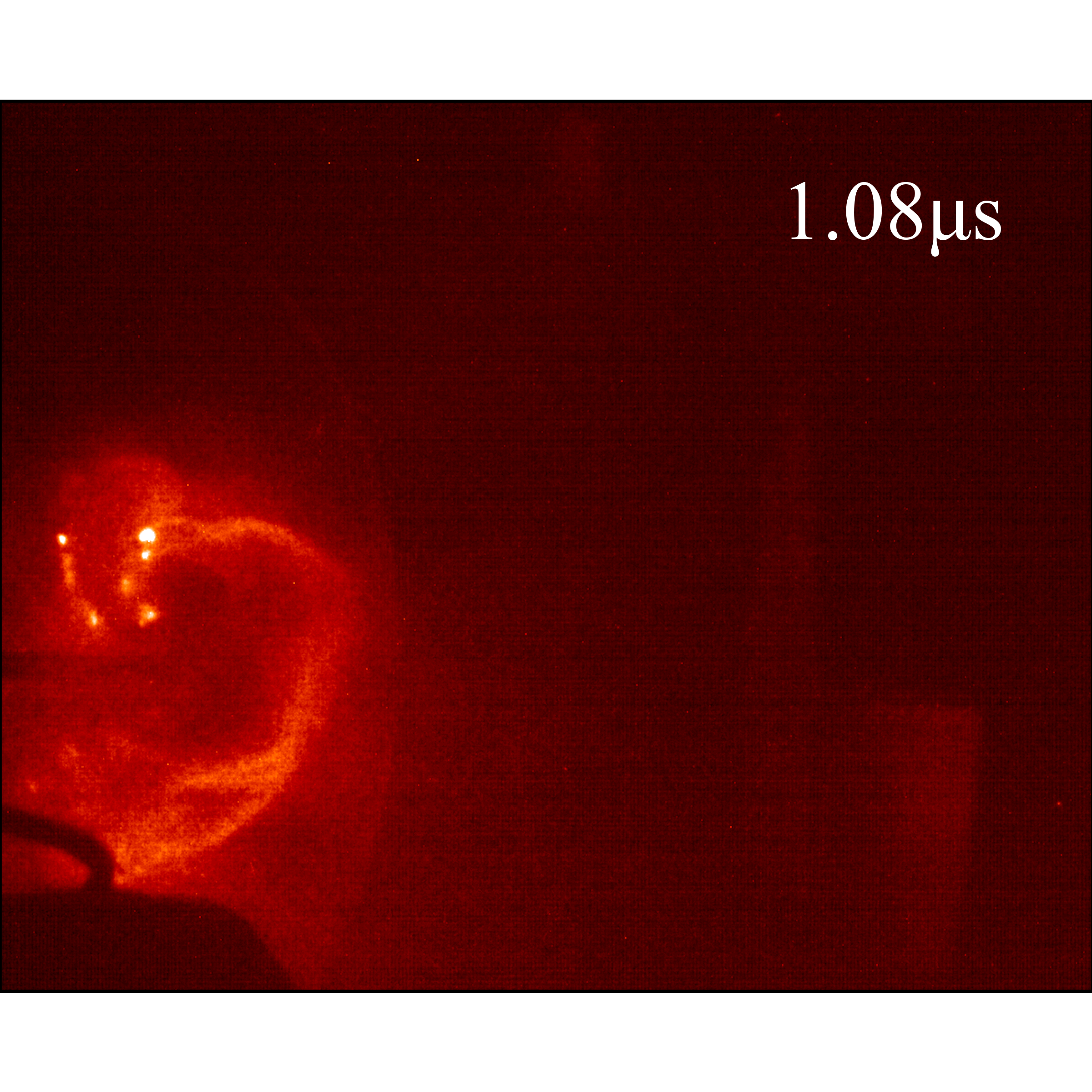
Acoustically Confined Microwave Plasma
Here is a triptych of behaviors observed in a microwave plasma. This plasma was confined to the center of its spherical container using the pycnoclinic acoustic force as described in Phys. Rev. E 98, 043103 (2018) . Videos of the effect may be found in the supplemental material of that paper.
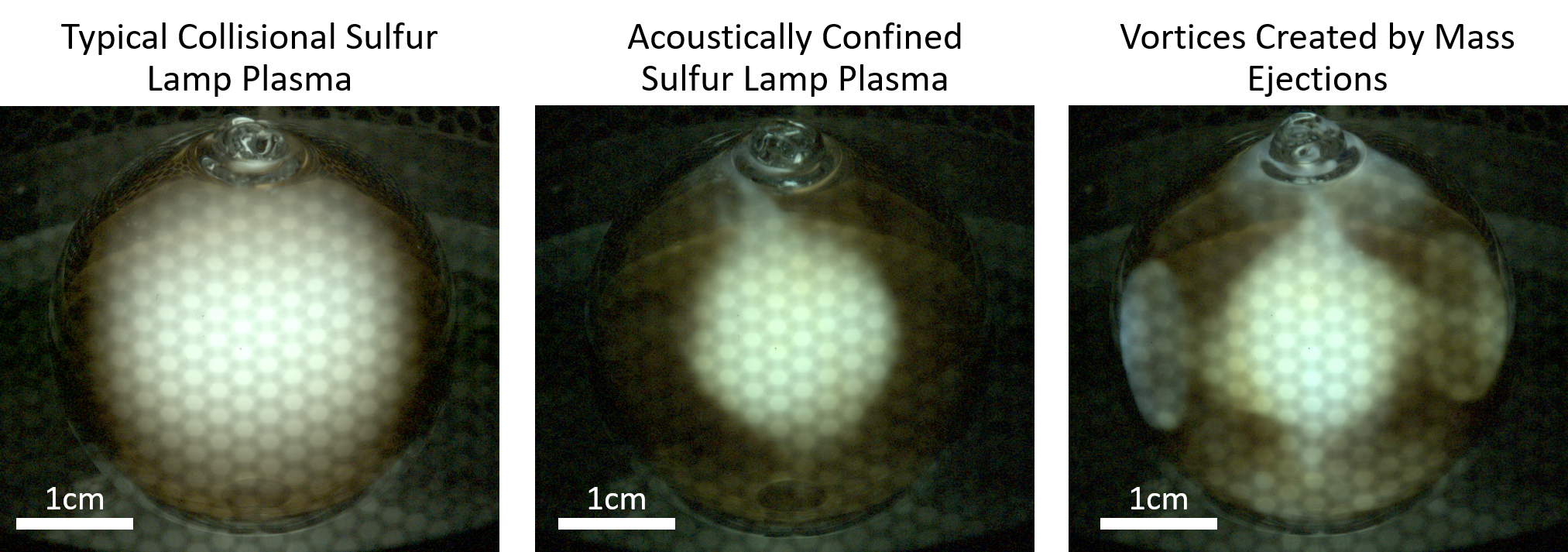
Convection in a central force due to a spherical sound wave
This gif shows a breather mode sound field turning on and causing convection to move around luminous gas. Because the acoustic radiation pressure is due to a spherically symmetric mode, the direction of buoyant acceleration is radial. We discussed this effect and how it is similar to convection in stars and on planets in Phs. Rev. Lett. 130, 034002 (2023)
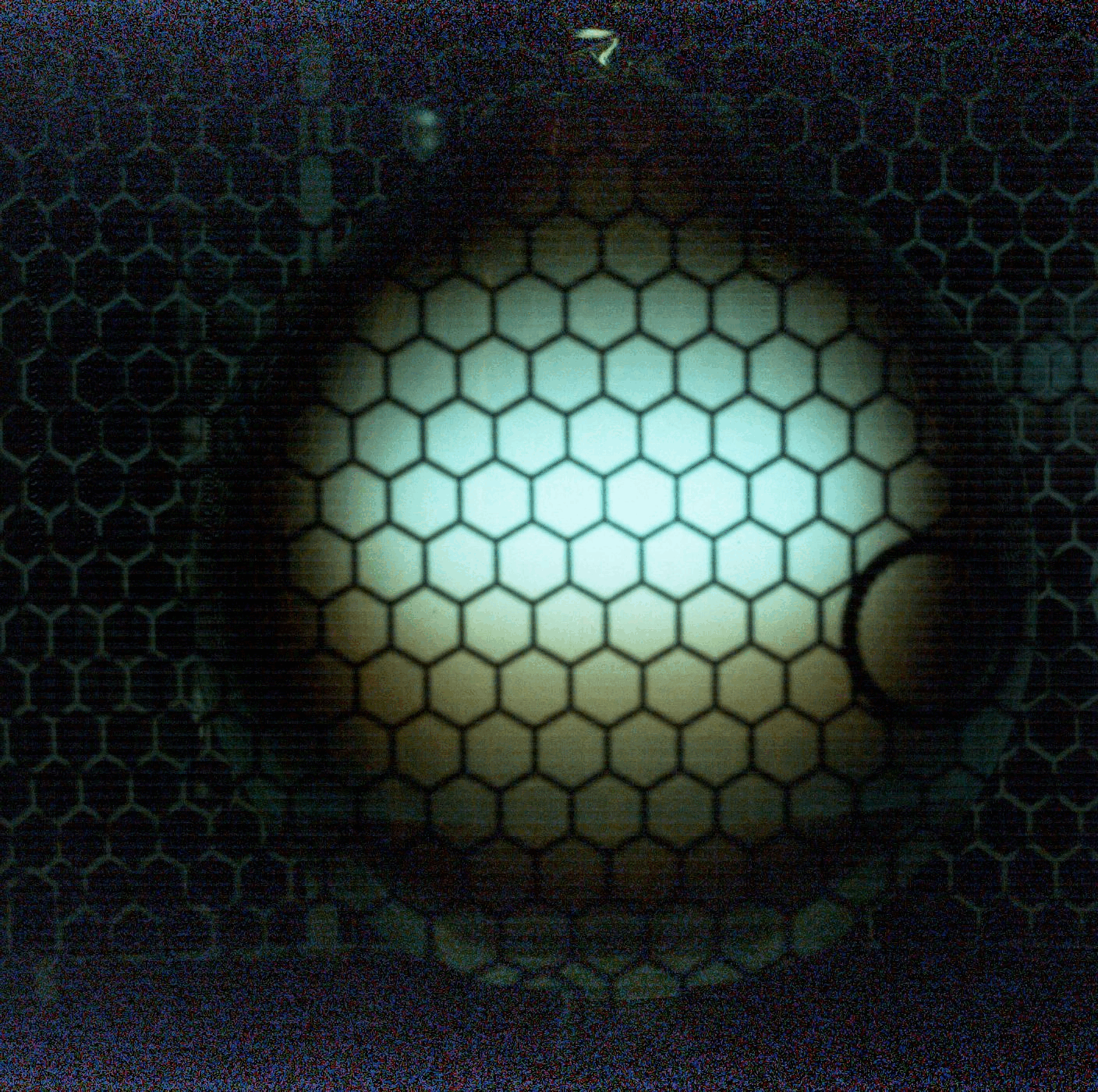
Schlieren of Convection in Standing Sound Wave
Schlieren visualization of a standing sound wave generated by a TinyLev acoustic levitator. The thin, horizontal wire is heated with a small current. The video shows how the acoustic field imparts a force similar to buoyancy on the hot plumes as they rise from the wire. When the sound field turns off, a buoyant plume floats upward.
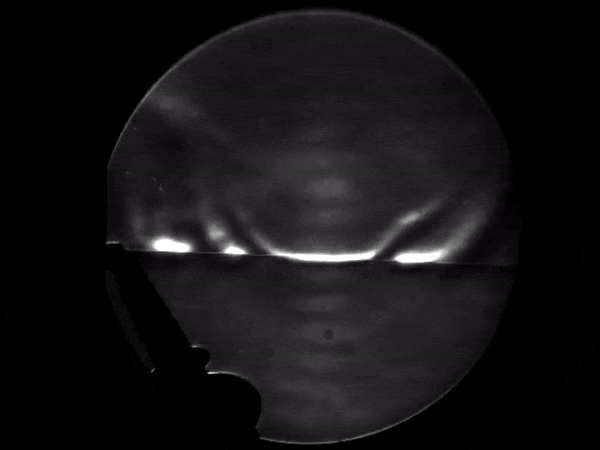
Dense Plasma Focus
A series of framing camera images stitched into a video of the run down, and pinch phase of a 200 J dense plasma focus built at UCLA. The central anode has a diameter of around 5 mm. The sheath reaches a velocity of around 50 km/s. This device produces more than 10,000 neutrons during such an event. More information about this device can be found in Instruments 2, 6 (2018)
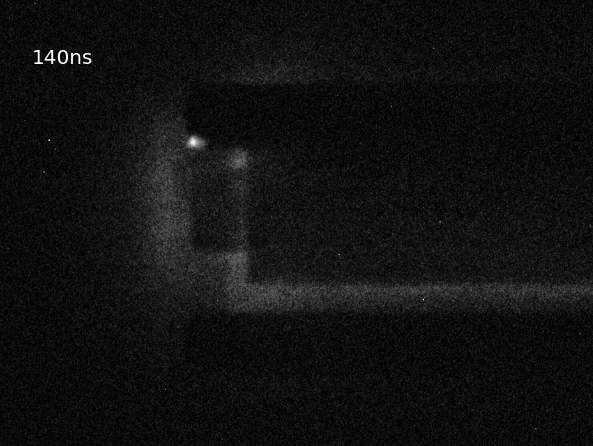
Dense Microplasma Shutter
A series of framing camera images of a spark discharge forming between two electrodes in 10 bar Xe. In the first frame, a 24,000 K spark discharge is formed after a threshold voltage around 5 kV is exceeded. In subsequent frames a right-going 8 μJ pulse from a YAG is focused between the two electrodes. As the laser focuses a second plasma forms as seen to the left of the spark plasma. The spark plasma acts as a 24,000 K blackbody and so absorbs the 532 nm light - preventing it from propagating beyond the spark. More information about this device can be found in Appl. Phys. Lett. 105, 223501 (2014)

Microwave Plasma Sondhauss
This video shows an air plasma generated by 2.5 GHz microwaves. I briefly modulate the frequency and play a few tones. Then I stop, pause, and increase the microwave power. At the elevated microwave power, the gas in the base of the bulb is sufficiently heated such that it kicks off a Sondhauss resonance with a frequency around 150 Hz (This is the buzzing which starts at about 12 seconds). The acoustic motion causes significant variation in the reflected microwave.
Microwave Plasma Speaker
In this video I light an argon plasma in a spherical bulb with around 1 kW of microwave power. I then add air to the plasma while keeping it lit in order to bring it to atmospheric pressure. By modulating the incident microwave power it is possible to induce time-varying heating in the plasma. I then play a song using the plasma as a speaker.
Thermoacoustic Trombone
A Sondhauss tube is a remarkable device which generates sound via positive feedback due to a temperature gradient across a 'stack' established by a heat source. In this video, I demonstrate that this method of generating sound is stable to deformations in the resonant cavity. We predict that a similar effect may be used to achieve very intense, stable sound fields in spherical microwave plasmas Phys. Rev. E 100, 033204 (2019) If such self oscillation is demonstrated in that system, I believe it may prove to be an interesting laboratory model of a Cepheid Variable.
Bathtub Corrugahorn
Here is my version of a type of instrument described by Frank Crawford in "Singing Corrugated Pipes". This device is a unique example of continuous wave energy (i.e. the wind flowing through the pipe) generating sound. Note the abrupt change between frequencies as the rate of airflow increases.
Laser Breakdown of Air
In this video a ~500 mJ, 5ns laser pulse is focused by the lens in the foreground. As it focuses the electric field of the pulse becomes sufficiently high that the air begins to ionize. Once the air begins to ionize it absorbs much of the remaining pulse energy and rapidly heats. As it heats it becomes sufficiently hot that it is luminous and expands rapidly generating a shock wave.